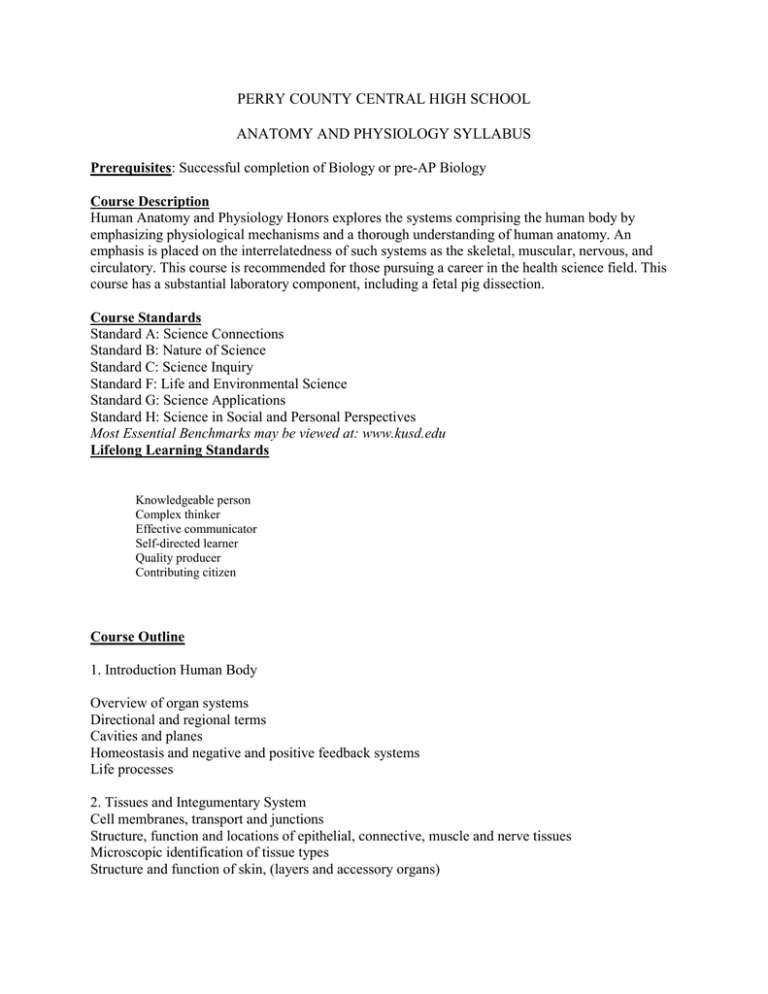Prerequisites
advertisement

PERRY COUNTY CENTRAL HIGH SCHOOL ANATOMY AND PHYSIOLOGY SYLLABUS Prerequisites: Successful completion of Biology or pre-AP Biology Course Description Human Anatomy and Physiology Honors explores the systems comprising the human body by emphasizing physiological mechanisms and a thorough understanding of human anatomy. An emphasis is placed on the interrelatedness of such systems as the skeletal, muscular, nervous, and circulatory. This course is recommended for those pursuing a career in the health science field. This course has a substantial laboratory component, including a fetal pig dissection. Course Standards Standard A: Science Connections Standard B: Nature of Science Standard C: Science Inquiry Standard F: Life and Environmental Science Standard G: Science Applications Standard H: Science in Social and Personal Perspectives Most Essential Benchmarks may be viewed at: www.kusd.edu Lifelong Learning Standards Knowledgeable person Complex thinker Effective communicator Self-directed learner Quality producer Contributing citizen Course Outline 1. Introduction Human Body Overview of organ systems Directional and regional terms Cavities and planes Homeostasis and negative and positive feedback systems Life processes 2. Tissues and Integumentary System Cell membranes, transport and junctions Structure, function and locations of epithelial, connective, muscle and nerve tissues Microscopic identification of tissue types Structure and function of skin, (layers and accessory organs) 3. Skeletal System Functions of skeletal system Anatomy of long bone Bone histology Naming all bones of axial and appendicular skeleton Formation, growth and repair Structural and functional classification of joints Types of movement Calcium homeostasis 4. Muscular System Functions of muscular system Names of all major muscles Origin, insertion and action Sliding Filament Model Neuromuscular junction Structure (gross and microscopic) Physiology of muscle contraction Muscle metabolism (ATP) Fiber types 5. Cardiovascular System Functions of circulatory system Heart structures (chambers, valves, vessels) Circulatory routes (systemic, pulmonary, coronary and hepatic portal) Blood vessels and pressure Blood components, function and typing Blood clotting Regulation and conduction (EKG) 6. Lymphatic/Immune System Functions of lymphatic system Structures (vessels, nodes, cells) Lines of defense Humoral immune response Cell mediated immune response Immune cell types Disease/AIDS 7. Digestion and Nutrition Functions of digestive organs Modes of mechanical digestion Chemical digestion (hormones, enzymes, pH) Absorption and elimination Name parts of GI Tract and accessory organs Nutrition and metabolism (production of ATP) 8. Excretory System Functions of urinary system Kidney, ureter, bladder, urethra Microanatomy and function of nephron 9. Respiratory System Functions of respiratory system Anatomy of respiratory tract Mechanics and regulation of breathing Gas exchange and gas laws 10. Nervous System Functions of nervous system Nerve cell anatomy Neural physiology (action potential, synaptic transmission, Na/K pump) Brain anatomy and hemispheres Spinal cord anatomy, reflex arc PNS (autonomic and somatic) Sensory motor nerve functions Sensory organs 11. Endocrine System Functions of endocrine system Naming organs/glands/cells and their hormones Hormone types and target cells Homeostasis and feedback loops Chemical messengers 12. Reproductive System Functions reproductive systems Male and female anatomy Menstrual cycle Meiosis/gamete production Board-Approved Instructional Materials Marieb, Elaine N. and Katja Hoehn (2007). Human Anatomy & Physiology, (7th Ed.) PearsonBenjamin Cummings. Resources for Parents: Infinate Campus Parent Portal Methods of Assessment Quizzes, Exams, Assignments, and Cat Dissection. Final exam is 25% of the final grade. Board-Approved Grading Scale 93-100 84-92 75-83 68-74 67 and A B C D below F






